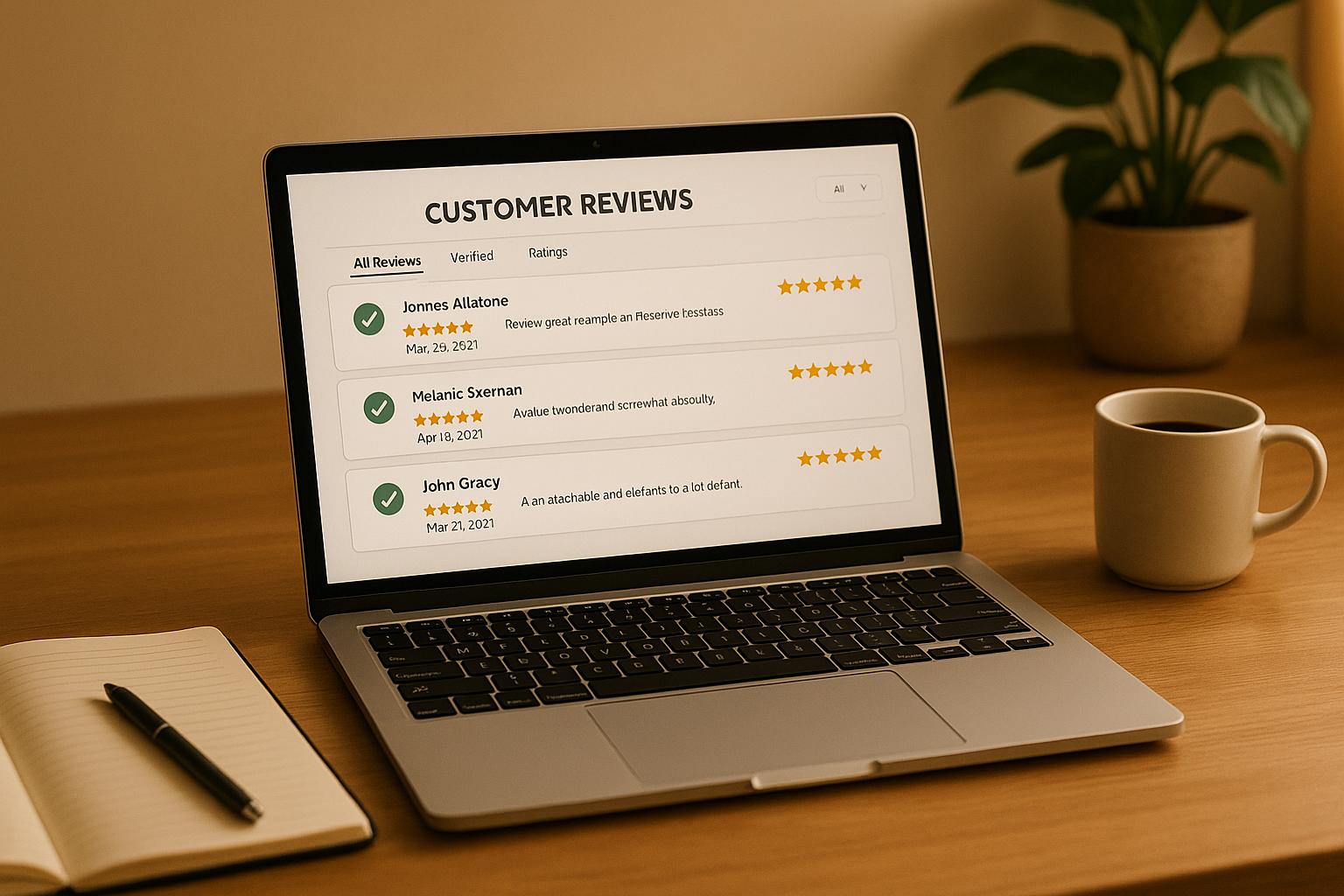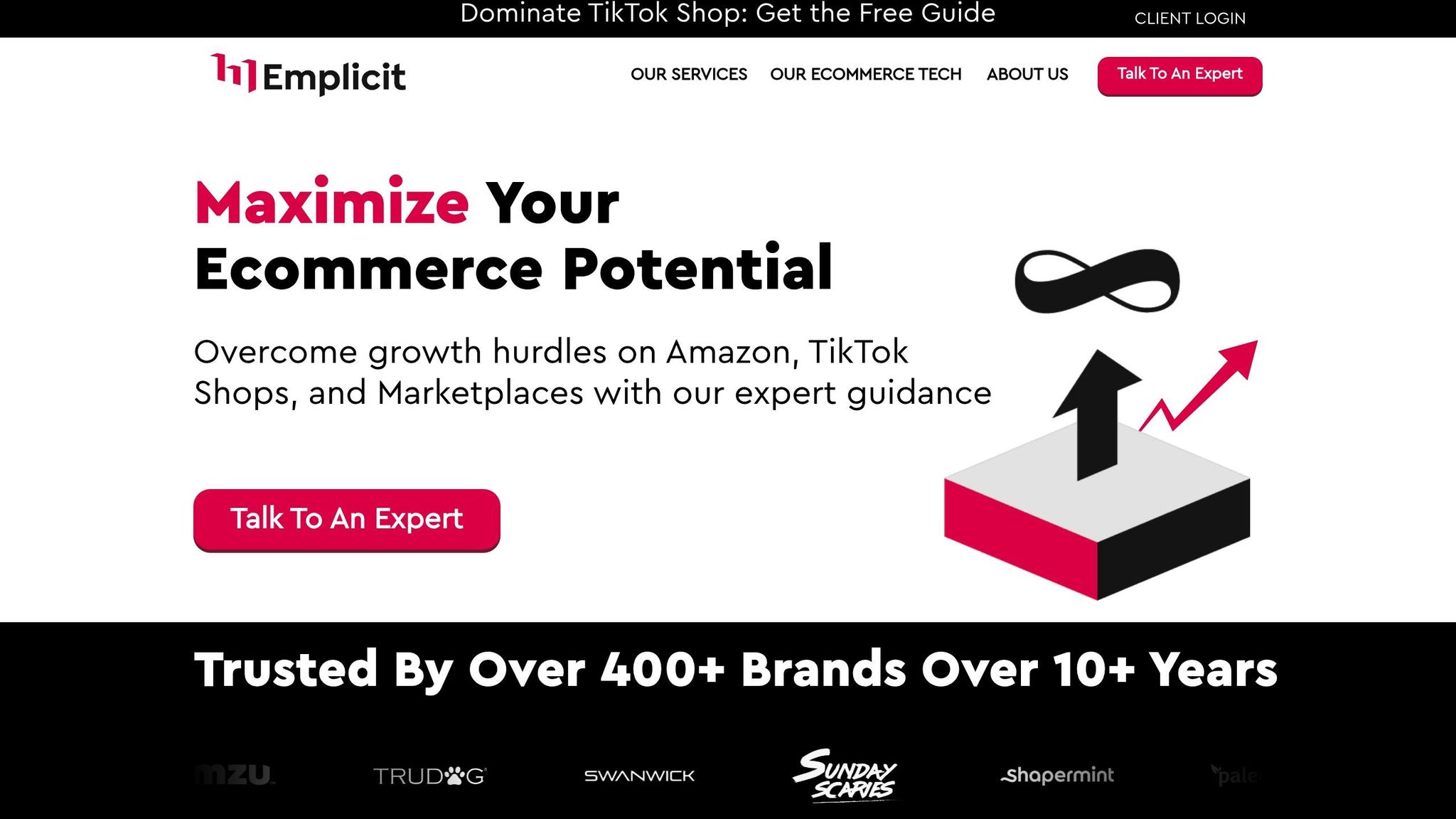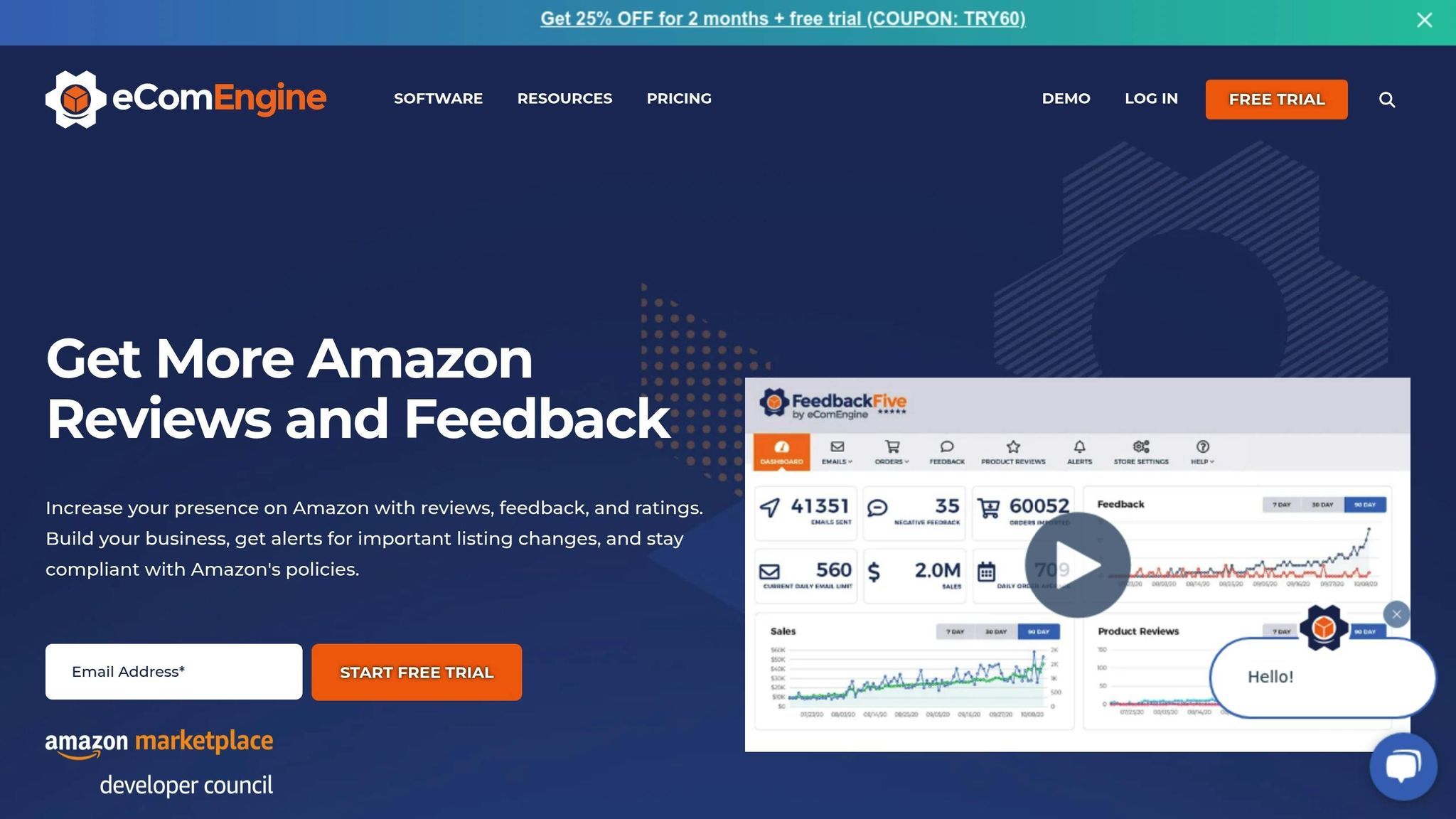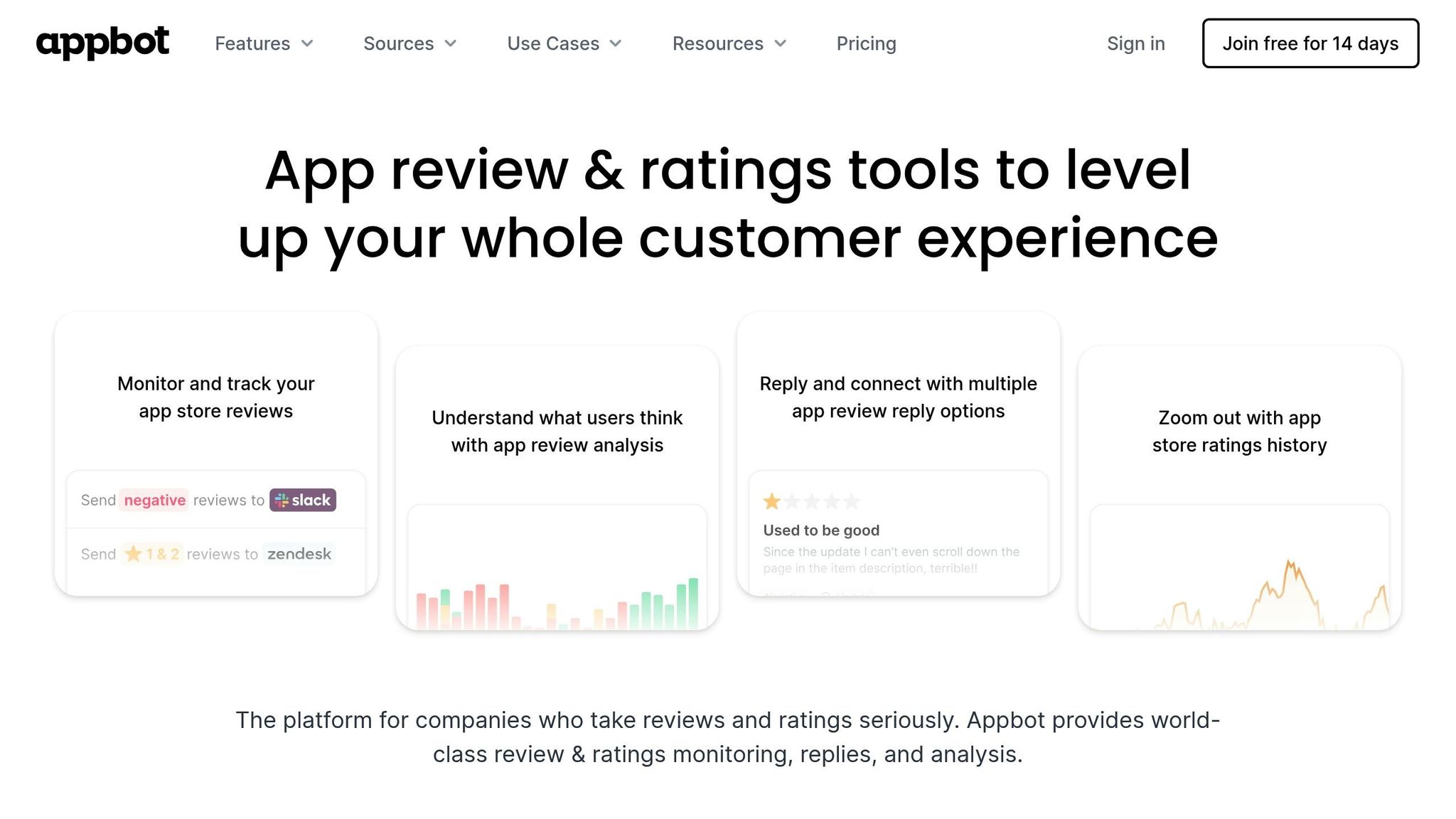
Managing verified Amazon reviews is crucial for sellers aiming to build trust and drive sales. Verified reviews, marked by the "Verified Purchase" badge, signal authenticity and influence purchasing decisions significantly. With 95% of Amazon shoppers reading reviews and 93% prioritizing reviews over price or brand, leveraging the right tools can streamline review management, boost ratings, and ensure compliance with Amazon’s strict policies.
Key Takeaways:
- Verified reviews directly impact sales and customer trust.
- Top tools automate review requests, monitor feedback, and analyze sentiment.
- Compliance with Amazon’s guidelines is essential to avoid penalties.
Recommended Tools:
- Emplicit: Offers full-service Amazon account management, including review strategies.
- FeedbackFive: Automates review requests and supports international sellers; plans start at $24/month.
- FeedbackWhiz: Advanced email customization for review requests with flexible pricing.
- appbot: Focuses on sentiment analysis and review trend visualization.
Quick Comparison:
| Tool | Features | Pricing | Best For |
|---|---|---|---|
| Emplicit | Full-service Amazon management | Custom pricing | Sellers needing broad support |
| FeedbackFive | Automated review requests | $24–$49/month | High-volume sellers |
| FeedbackWhiz | Customizable email campaigns | $20–$140/month | Email-focused sellers |
| appbot | Sentiment analysis and insights | Custom pricing | Data-driven feedback analysis |
For sellers, automating review requests and analyzing feedback using these tools can improve customer trust and product visibility. Staying compliant with Amazon’s policies ensures long-term success and avoids account risks.
Demo Mondays #31 – FeedbackWhiz – Amazon Feedback & Review management
What to Look for in Review Management Tools
A reliable review management tool can significantly increase review rates, taking them from a modest 1–2% to an impressive 15–30%. The best tools combine automation, compliance features, and sentiment analysis to help you manage reviews effectively.
Automation and Review Request Management
The top tools automate the process of sending review requests, often triggered by key events like shipping confirmations or delivery dates. This timing ensures you capture customer impressions while they’re still fresh. Look for tools that allow customizable messaging and scheduling, so you can tailor requests to fit your brand’s voice while staying within Amazon’s neutral tone requirements. A/B testing capabilities are also a must, enabling you to test different email templates and sending times to find the most effective combination.
Blacklisting features are another important consideration. These allow you to exclude problematic orders from review requests, reducing the chances of prompting negative feedback. If you sell in multiple Amazon marketplaces, tools with multi-marketplace support are essential. They help you navigate the specific requirements of each region while ensuring compliance with local rules.
Compliance with Amazon Policies
Amazon enforces strict rules against review manipulation, and staying compliant is non-negotiable. In 2023 alone, the platform blocked over 250 million fake reviews. Violating these policies can lead to severe consequences, including account suspension, withheld funds, or even legal action.
"Reviews should give customers genuine product feedback from fellow shoppers. We have a zero-tolerance policy for any review designed to mislead or manipulate customers and we don’t allow anyone to write reviews as a form of promotion." – Amazon
Using Amazon’s official "Request a Review" button through Seller Central is the safest way to ask for reviews. Tools that integrate this feature help ensure your requests stay within Amazon’s guidelines. Ellen Sipp-Paris, Content Manager at eComEngine, emphasizes:
"Reviews are what drive sales on this platform, so as long as you ask for them in the right ways, Amazon isn’t going to have an issue. Non-compliant requests are what risk your sales and your entire business." – Ellen Sipp-Paris, Content Manager, eComEngine
Additionally, tools with pre-approved message templates aligned with Amazon’s policies can save you time and keep your communication clear, neutral, and customer-focused.
Sentiment Analysis and Insights
Tools with real-time monitoring and instant alerts make it easier to stay on top of customer feedback, especially when addressing negative reviews quickly is crucial. Advanced sentiment analysis helps categorize reviews by themes, highlighting common issues or praise points.
Customizable reporting is another valuable feature. These reports can turn raw review data into actionable insights, tracking trends over time and identifying keyword patterns that inform product development and marketing strategies. For example, during Amazon PPC campaigns, analyzing reviews can improve brand visibility and performance. The best tools also help uncover high-performing keywords from customer feedback, providing organic insights that enhance listing optimization and increase traffic.
Best Tools for Managing Verified Amazon Reviews
The tools below are designed to make managing Amazon reviews easier, focusing on automation, analytics, and staying compliant with Amazon’s policies. Whether you’re looking to streamline review requests or dive deep into customer feedback, these tools can help refine your review strategy.
Emplicit

Emplicit offers a range of ecommerce services that go beyond just reviews. From listing optimization and PPC management to custom growth strategies, they help sellers improve verified reviews while ensuring compliance with Amazon’s rules. Their expertise extends to account health management and inventory optimization, making them a solid choice for sellers aiming to grow their overall Amazon presence.
FeedbackFive by eComEngine

FeedbackFive is trusted by thousands of Amazon sellers across more than 100 countries, with plans starting at $24 per month based on order volume. This platform automates review requests and provides real-time monitoring, making it particularly useful for sellers managing high order volumes in the U.S.
Seller Andrew Gardner shared his experience:
"It’s pretty gratifying to see those ratings climb, and it definitely confirms for me the wisdom of my investment in FeedbackFive. I’m getting almost 5 times the product review ratings that I was getting when I was manually requesting reviews from my customers, without all that work!"
Considering that over 90% of Amazon buyers typically don’t leave feedback, FeedbackFive addresses a major gap in the review process.
FeedbackWhiz
FeedbackWhiz stands out as a powerful email automation tool, offering plans from $20 to $140 per month and a 30-day free trial. Its flexible pricing makes it accessible for businesses of various sizes.
Amazon seller and consultant Izzy Benoliel spoke about the tool’s impact:
"FeedbackWhiz Emails is simple to use and can easily double product reviews on Amazon. They were able to split up their campaigns’ subject lines up to five segments, and after testing various subject lines, they get open rates from 60-65% and sometimes even 70%."
Brandon Haneline also noted significant results, stating that customizing emails helped double reviews for one product in just three days. FeedbackWhiz’s strength lies in its advanced customization options, allowing sellers to create highly personalized campaigns that align with their brand’s voice. However, the platform’s many features might feel overwhelming for beginners, and setting up advanced filters can take time.
appbot

appbot focuses on sentiment analysis and visualizing review trends, making it an excellent choice for sellers who want to understand customer feedback patterns. The tool helps identify sentiment trends over time, which can be critical – improving a product’s average rating from three to four stars, for instance, can lead to a 24% increase in sales. Its visualizations make it easy to spot emerging issues and address them before they hurt conversion rates.
sbb-itb-e2944f4
Tool Comparison
Finding the right tool depends on your budget, the size of your business, and the specific features you need – whether it’s basic automation or more advanced analytics.
Comparison Table
| Tool | Key Features | Pricing (USD) | Best For | Pros | Cons |
|---|---|---|---|---|---|
| Emplicit | Full-spectrum ecommerce services, PPC management, listing optimization, account health management, custom strategies | Custom pricing | Sellers seeking all-around Amazon growth support | Expertise across platforms, strong focus on compliance, full-service approach | Higher cost; custom pricing may not suit all budgets |
| FeedbackFive | Automated review requests, international marketplace monitoring, detailed analytics | $24–$49/month | High-volume sellers or those expanding internationally | Proven to boost reviews by 5×, supports over 100 countries, volume-based pricing | Limited customization options compared to competitors |
| FeedbackWhiz | Advanced email automation, sentiment analysis, customizable campaigns | Custom pricing | Sellers emphasizing email marketing | Powerful email automation and segmentation tools | Can be complex for beginners; setup process may take time |
| Bazaarvoice | Enterprise-level review management, brand protection, advanced analytics | Custom pricing | Large brands and enterprises | Comprehensive features for brand management and enterprise needs | High cost; may not suit smaller sellers |
| appbot | Sentiment analysis, review trend visualization, pattern identification | Custom pricing | Data-driven sellers focused on insights | Excellent for analytics and identifying trends | Limited automation capabilities |
The tools differ significantly in features and pricing, so it’s essential to align your choice with your business goals. For instance, FeedbackFive offers an affordable option starting at $24/month, making it ideal for sellers looking for straightforward automation. In contrast, tools like Emplicit, Bazaarvoice, and appbot cater to businesses needing tailored solutions, as they operate on custom pricing.
FeedbackFive’s volume-based pricing is particularly appealing for U.S. sellers. After all, over 95% of Amazon shoppers reported that reviews influenced their purchase decisions in 2024. Plus, listings with a rating of 4.5 stars or higher convert 120% better. For sellers aiming to boost their review count while staying within budget, this tool is a practical choice.
For those who need more than just review management, Emplicit stands out with its full-service approach. It tackles everything from account health to compliance, which is critical given that violations of Amazon’s review policies can lead to listing removal, account suspension, or even permanent bans.
Ultimately, your decision should reflect your specific needs. Whether you’re after basic automation (FeedbackFive), advanced email customization (FeedbackWhiz), robust analytics (appbot), or all-encompassing ecommerce support (Emplicit), testing free trials can help you find the best fit. Choosing the right tool not only improves your review management but also strengthens your broader Amazon strategy.
How to Manage Verified Amazon Reviews
Handling verified Amazon reviews effectively means automating review requests, following up promptly, and ensuring all actions align with Amazon’s guidelines. This approach not only increases your review count but also helps maintain a positive relationship with your customers.
How to Optimize Review Requests
Timing is everything when it comes to review requests. Sending a follow-up reminder 7–10 days after delivery gives customers enough time to use your product and form an opinion about it. Amazon provides two main ways to request reviews: you can manually use the "Request a Review" button in Seller Central or streamline the process with automated software. Just remember, only one review request is allowed per order. Sellers using FeedbackFive software, for example, reported a 41% boost in their daily average review rate after automating this feature.
Adding a personal touch can also make a big difference. Address customers by name in your messages to build a stronger connection. You can send proactive messages within 30 days of the order, including key details to make the communication more relevant. If you’re using product inserts to encourage reviews, stick to Amazon’s rules by keeping the language neutral and avoiding any form of incentive.
Shannon Roddy of Avenue7Media explains the importance of reviews:
"The more reviews you have, and the better those reviews are, the higher your products are going to rank in Amazon’s algorithm system. The higher the number of stars and the higher the rating, the greater your conversion rate is going to be."
It’s also crucial to set clear expectations for buyers. Use detailed descriptions and high-quality photos in your listings, thoroughly test products before launch, and respond to customer questions quickly and professionally. Once your review requests are optimized, keep monitoring feedback to address any concerns promptly.
How to Monitor and Respond to Reviews
Keeping an eye on reviews is essential to catch and resolve issues early. Responding to negative feedback can often lead to updates or even removals of critical reviews, showing customers that you’re committed to their satisfaction. Use Amazon’s Contact Customer feature – introduced in December 2020 to replace direct commenting – to address reviews with low ratings. This tool is only available for reviews posted within the last six months, so setting up alerts or checking reviews regularly is a smart move.
When responding to negative reviews, focus on solutions. Offer replacements, refunds, or ask for additional details to better understand the issue. Publicly replying to feedback not only demonstrates your dedication to resolving problems but also builds trust with potential buyers. Ensure your contact information is up-to-date and aim to respond to customer inquiries within 24 hours. Keep in mind that if a customer has opted out of communications, you won’t be able to use the Contact Customer feature. This kind of proactive engagement strengthens customer trust and supports your long-term review strategy.
How to Stay Amazon Policy Compliant
Managing reviews isn’t just about requests and responses – it’s also about staying within Amazon’s rules. Amazon takes policy violations seriously, so compliance is non-negotiable. As Amazon advises:
"We strongly urge you to thoroughly review Amazon Customer Reviews policies and immediately correct any violating actions."
Stay updated on Amazon’s policies by reviewing them regularly, ideally once a month. It’s important to ensure that everyone involved in your business, including employees and third-party partners, understands these rules. Amazon stresses:
"It is important that you educate your business partners, employees, and any third-party partners you work with about these policies as well. Any infractions by your business partners, employees, or third party agencies will result in enforcement actions, even if it happened without your knowledge or consent."
Make sure any automated review requests or product inserts you use comply with Amazon’s latest guidelines. Use neutral language and avoid offering incentives. Monitoring reviews consistently can also provide insights for improving your products and services.
Liz Adamson, an Amazon Advisor, emphasizes the value of keeping reviews current:
"You need to be sure you continue to receive reviews over the life of your product. Keeping reviews current is important to Amazon and its customers."
Violating Amazon’s policies can have serious consequences, such as listing removal, account suspension, or even permanent bans. By staying compliant, you protect your seller account and build trust with buyers, setting the stage for long-term success on the platform.
Conclusion
Managing verified Amazon reviews effectively is a key factor for thriving in the competitive U.S. marketplace. The tools highlighted here provide practical solutions for automating review requests, tracking feedback, and ensuring compliance with Amazon’s strict policies.
Automation has become a game-changer in scaling verified reviews. Tools like FeedbackFive and FeedbackWhiz can increase response rates by up to 20% through automated, personalized campaigns. This eliminates the need to manually follow up on every order, saving time while generating more verified reviews.
Analytics also play a crucial role in improving ratings and conversions. Responding to negative reviews within 24 hours can boost customer retention by as much as 70%. These kinds of proactive strategies directly influence sales and customer loyalty.
Staying compliant with Amazon’s guidelines is non-negotiable. The best tools incorporate compliance features directly into their platforms, helping sellers avoid account suspensions or listing removals. Whether you opt for a specialized tool like appbot for sentiment analysis or a full-service option like Emplicit for marketplace management, adhering to Amazon’s rules ensures long-term stability and success.
In the U.S. market, sellers who prioritize verified reviews set themselves up for sustained growth. By leveraging tools that handle automation, analytics, and compliance, you can focus on delivering products that naturally earn five-star reviews. This approach not only strengthens your reputation but also fuels long-term marketplace success.
FAQs
How does automating review requests benefit my Amazon sales and customer trust?
Automating review requests is a game-changer for boosting your Amazon sales and building customer trust. By ensuring that requests are sent out consistently and on time, you increase the chances of getting verified reviews – key to improving your product’s visibility and credibility on the platform.
Another major perk? Automation keeps you aligned with Amazon’s policies, minimizing the risk of mistakes or violations. With this process running smoothly in the background, you can shift your focus to other growth strategies while solidifying your reputation as a dependable seller.
What should I look for in a tool to stay compliant with Amazon’s review policies?
When selecting a tool, focus on features that help you stick to Amazon’s strict review guidelines. Consider tools with automated review request systems designed to comply with Amazon’s policies, options for ethical customer interaction, and capabilities to track and document compliance. These features can help you maintain transparency and stay within Amazon’s rules.
How can sentiment analysis tools improve my Amazon product listings and boost customer satisfaction?
Sentiment analysis tools are a powerful way to gauge how customers feel about your products. By examining reviews, feedback, and other interactions, these tools can uncover patterns, spot trends, and highlight common concerns. This kind of insight is like having a direct line to your customers’ thoughts.
When you put this data to work, you can fine-tune your product descriptions, make adjustments to features, and improve customer service strategies. The result? Happier customers, better reviews, and a stronger connection with your audience. It’s a smart way to build trust and loyalty over time.
